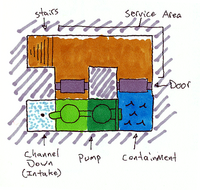- v50 information can now be added to pages in the main namespace. v0.47 information can still be found in the DF2014 namespace. See here for more details on the new versioning policy.
- Use this page to report any issues related to the migration.
v0.34:Aqueduct
| Part of a number of articles on |
| Projects |
|---|
| Basic |
| Aqueduct • Archery tower • Atom smasher • Danger room • Dam • Garbage dump • Mass pit • Moat • Pit trap • Reservoir• Sally port • Swimming pool • Tower • Tree farm |
| Advanced |
| Drowning chamber • Magma piston • Obsidian farm • Pump stack • Silk farm • Water reactor |
| This article is about an older version of DF. |
An aqueduct is any set of elements that carries water or magma (the game's two types of fluids) from one location to another. Using a combination of channels, tunnels, screw pumps, and natural or constructed floors and walls, an aqueduct taps into a natural source of either and creates a path for them to follow, using a combination of pressure and gravity to funnel it to its destination. Aqueducts are usually a means to an end and not an end in and of themselves.
Although simple aqueducts don't need much utility, certain measures like roofing over channels and installing lever-bound floodgates or bridges are useful for safety, maintenance, and modification reasons. More complicated aqueducts often handle pressurized flows; since in-game pressure sometimes behaves in counter intuitive ways, it is generally a good idea to familiarize oneself with its mechanics before undertaking any large project, lest flooding occurs.
Water
The most primitive kind of aqueduct is an open surface channel, usually dug out from the local river or lake to your fortress to provide your dwarves with a less exposed fishing outlet and a source of clean drinking water. This is often combined with an equally simple reservoir and/or a well:
Simple aqueduct
top view
≈≈≈......║++ ≈ = River/lake
≈≈≈......║++ ≈ = Channel filled with water
≈≈≈≈≈≈≈≈≈║≈○ +. = Floor (indoor/outdoor)
≈≈≈≈.....║++ ║ = Wall
≈≈≈≈.....║++ ○ = Well
Only rivers and some murky pools and lakes provide fresh surface water suitable for drinking and cleaning the wounds of injured dwarves. Oceans always provide salt water, lakes may provide stagnant or salt water and murky pools are usually stagnant. Although these water sources can still be fished and used for various other purposes, they cannot be drunk from or used in injury treatment without a high infection risk, and must be desalinated through a screw pump first. Fortifications can be useful as they may prevent swimming creatures from pathing into your fortress through your waterworks, but only at depths less than 7/7, and creatures can be forced through fortifications (and vertical bars) by fluid flow. For better security, route your water supply upwards through a grate or set of horizontal bars--swimming creatures will be blocked, building destroyers will be stymied, and flow cannot push creatures vertically.
Another useful utility is a "dump" channel, an aqueduct that dumps a large body of fluid off-map. Shallow reservoirs are often quick-dumped off the edge of the map at the caverns level, to take advantage of gravity and minimize digging, while more permanent installations can reduce fps slowdown by routing water through fortifications carved at the map's edge.
Magma
Magma is located in the bowels of the earth, and bringing it (closer) to the surface requires a special construction: the pump stack (aqueducts cannot "push" fluids up z-levels). Note that magma is much more viscous than water, so an over-application of pressure will be necessary to get a significant flow rate. Magma routing requires magma-safe materials.
